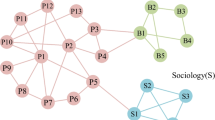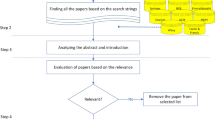Abstract
To ensure the quality of online review, more and more location-based social networks (LBSNs), like Yelp, have established the filtering systems to detect groups of review spammers. This is not an easy task. Review spammers use camouflage methods to maintain their spam behavior in a very low density to try to conceal themselves in normal users. These camouflaged spammers, driven by profits, are hired by some stores to write fake reviews in groups so as to raise these stores or to belittle their competitors. To avoid the unhealthy competition, in this paper, we propose a novel detection mechanism to discern collusive review spammers, including individuals and groups. The key point of our mechanism is to identify hidden spammers through multiple anomalous relationship features, especially the collusive relation between review spammers and the business competition between locations. Based on multi-view anomalous features, two detection models are proposed for individual and group discovery, respectively. For malicious individuals, a detection model based on Markov Random Field (MRF) is constructed to formalize an inference problem, where the corresponding marginal distribution of users and locations are calculated respectively. For review spammer groups, a hierarchical agglomerative clustering algorithm is conceived according to a new validity index to make sure the collusion relation in each group is close at most. Experiment results show that our method can detect collusive spammers and groups more accurately and comprehensively over the current researches. The additional experiments also show the effectiveness of each anomalous feature in detecting review spammers.















Similar content being viewed by others
References
Akoglu, L., Chandy, R., Faloutsos, C.: Opinion fraud detection in online reviews by network effects[J]. ICWSM. 13, 2–11 (2013)
Chan C L, Lai J, Hooi B, et al. The Message or the Messenger? Inferring Virality and Diffusion Structure from Online Petition Signature Data[C]// International Conference on Social Informatics. Springer, Cham 499–517 (2017)
D’onfro J.: A Whopping 20% of Yelp Reviews Are Fake[EB/OL].http://read.bi/1M03jxl (2013)
Feng S, Banerjee R, Choi Y. Syntactic stylometry for deception detection[C]//proceedings of the 50th annual meeting of the Association for Computational Linguistics: short papers-volume 2. Association for Computational Linguistics 171–175 (2012)
Feng S, Xing L, Gogar A, et al. Distributional footprints of deceptive product reviews[C]//seventh international AAAI conference onweblogs and social Media (2013)
Hooi B, Song H A, Beutel A, et al. FRAUDAR: Bounding Graph Fraud in the Face of Camouflage[C]// ACM SIGKDD International Conference on Knowledge Discovery and Data Mining. ACM 895–904 (2016)
Jindal N, Liu B. Opinion spam and analysis[C]//proceedings of the 2008 international conference on web search and data mining. ACM. 219–230 (2008)
KC S, Mukherjee A. On the temporal dynamics of opinion spamming: case studies on yelp[C]//proceedings of the 25th international conference on world wide web. International World Wide Web Conferences Steering Committee 369–379 (2016)
Kindermann, R., Snell, J.L.: Markov Random Fields and their Applications[M]. American Mathematical Society, Providence (1980)
Li, F., Huang, M., Yang, Y., et al.: Learning to identify review spam[C]//IJCAI proceedings-international joint conference on. Artif. Intell. 22(3), 2488 (2011)
Li H, Chen Z, Liu B, et al. Spotting fake reviews via collective positive-unlabeled learning[C]//data mining (ICDM), 2014 IEEE international conference on. IEEE 899–904 (2014)
Li H, Chen Z, Mukherjee A, et al. Analyzing and detecting opinion spam on a large-scale dataset via temporal and spatial patterns[C]//ninth international AAAI conference on web and social Media 634–637 (2015)
Liu S, Hooi B, Faloutsos C. HoloScope: topology-and-spike aware fraud detection[C]// ACM on conference on information and knowledge management. ACM 1539–1548 (2017)
Luca, M., Zervas, G.: Fake it till you make it: reputation, competition, and yelp review fraud[J]. Management science journal of the Institute for Operations Research & the management. Sciences. 62, 3412–3427 (2016)
Mukherjee A, Liu B, Glance N. Spotting fake reviewer groups in consumer reviews[C]//proceedings of the 21st international conference on world wide web. ACM 191–200 (2012)
Mukherjee A, Kumar A, Liu B, et al. Spotting opinion spammers using behavioral footprints[C]//proceedings of the 19th ACM SIGKDD international conference on knowledge discovery and data mining. ACM 632–640 (2013)
Mukherjee A, Venkataraman V, Liu B, et al. What yelp fake review filter might be doing?[C]//ICWSM. (2013)
Ott M, Choi Y, Cardie C, et al. Finding deceptive opinion spam by any stretch of the imagination[C]//proceedings of the 49th annual meeting of the Association for Computational Linguistics: human language technologies-volume 1. Association for Computational Linguistics 309–319 (2011)
Rahman, M., Carbunar, B., Ballesteros, J., Chau, D.H.P.: To catch a fake: curbing deceptive yelp ratings and venues[J]. Stat. Anal. Data Min. ASA Data Sci. J. 8(3), 147–161 (2015)
Rayana S, Akoglu L. Collective opinion spam detection: bridging review networks and metadata[C]//Proceedings of the 21th ACM SIGKDD international conference on knowledge discovery and data mining. ACM 985–994 (2015)
Rayana S, Akoglu L. Collective opinion spam detection using active inference[C]//proceedings of the 2016 SIAM international conference on data mining. Soc. Ind. Appl. Math. 630–638 (2016)
Shin K, Hooi B, Faloutsos C. M-zoom: fast dense-block detection in tensors with quality guarantees[C]// joint European conference on machine learning and knowledge discovery in databases. Springer International Publishing 264–280 (2016)
Wang G, Xie S, Liu B, et al. Review graph based online store review spammer detection[C]//data mining (ICDM), 2011 IEEE 11th international conference on. IEEE 1242–1247 (2011)
Xie S, Wang G, Lin S, et al. Review spam detection via temporal pattern discovery[C]//proceedings of the 18th ACM SIGKDD international conference on knowledge discovery and data mining. ACM. 823–831 (2012)
Xu C, Zhang J. Towards collusive fraud detection in online reviews[C]//data mining (ICDM), 2015 IEEE international conference on. IEEE 1051–1056 (2015)
Xu C, Zhang J. Combating product review spam campaigns via multiple heterogeneous pairwise features[C]//Proceedings of the 2015 SIAM international conference on data mining. Soc. Ind. Appl. Math. 172–180 (2015)
Xu C, Zhang J, Chang K, et al. Uncovering collusive spammers in Chinese review websites[C]//proceedings of the 22nd ACM international conference on conference on information & knowledge management. ACM 979–988 (2013)
Ye J, Akoglu L. Discovering opinion spammer groups by network footprints[M]//machine learning and knowledge discovery in databases. Springer International Publishing 267–282 (2015)
Yedidia, J.S., Freeman, W.T., Weiss, Y.: Understanding belief propagation and its generalizations[J]. Explor. Artif. Intell. New Millenium. 54(1), 276–286 (2002)
Zheng Y.: Location-based social networks: users[M]. Computing with spatial trajectories. Springer New York, 243–276 (2011)
Author information
Authors and Affiliations
Corresponding author
Additional information
This article belongs to the Topical Collection: Social Computing and Big Data Applications
Guest Editors: Xiaoming Fu, Hong Huang, Gareth Tyson, Lu Zheng, and Gang Wang
Rights and permissions
About this article
Cite this article
Cao, J., Xia, R., Guo, Y. et al. Collusion-aware detection of review spammers in location based social networks. World Wide Web 22, 2921–2951 (2019). https://doi.org/10.1007/s11280-018-0614-x
Received:
Revised:
Accepted:
Published:
Issue Date:
DOI: https://doi.org/10.1007/s11280-018-0614-x




